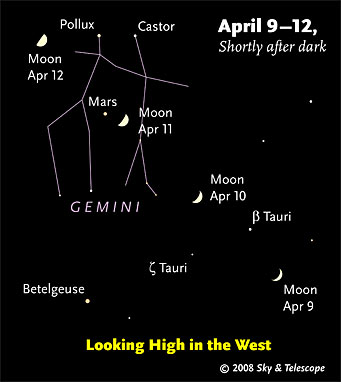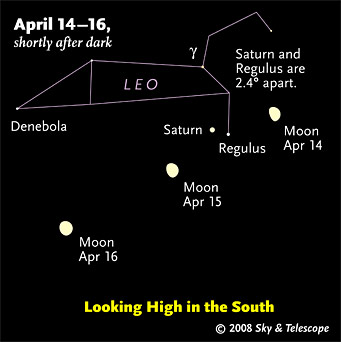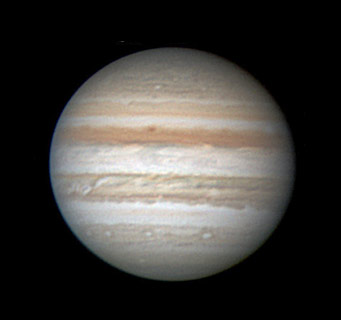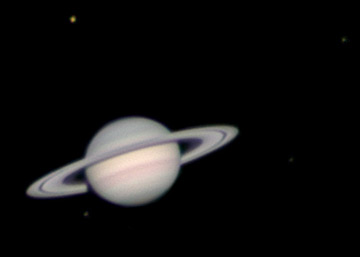Some daily events in the changing sky for April 11– 19.

The waxing Moon is crossing Gemini, where it passes Mars. These diagrams are exact for the middle of North America (longitude 90° west, latitude 40° north). European observers: move each Moon symbol a quarter of the way toward the one for the previous date.
Sky & Telescope diagram.
Friday, April 11
Saturday, April 12
Sunday, April 13
Monday, April 14
Tuesday, April 15
Wednesday, April 16
Thursday, April 17
Friday, April 18
Saturday, April 19

For skywatchers in the longitudes of North America, the waxing gibbous Moon passes Saturn and Regulus about halfway between the evenings of April 14th and 15th: in other words, at the time of early evening in the longitudes of China, Korea,and Japan (where the local date will be the evening of the 15th).
Sky & Telescope diagram
Want to become a better amateur astronomer? Learn your way around the constellations. They're the key to locating everything fainter and deeper to hunt with binoculars or a telescope. For an easy-to-use constellation guide covering the whole evening sky, use the big monthly foldout map in each issue of Sky & Telescope, the essential magazine of astronomy. Or download our free Getting Started in Astronomy booklet (which only has bimonthly maps).
Once you get a telescope, to put it to good use you'll need a detailed, large-scale sky atlas (set of maps; the standards are Sky Atlas 2000.0 or the smaller Pocket Sky Atlas) and good deep-sky guidebooks (such as Sky Atlas 2000.0 Companion by Strong and Sinnott, the even more detailed Night Sky Observer's Guide by Kepple and Sanner, or the enchanting though increasingly dated Burnham's Celestial Handbook). Read how to use them effectively.
More beginners' tips: "How to Start Right in Astronomy".
This Week's Planet Roundup

Jupiter is getting high enough now in early dawn to show detail well in a telescope . The North Equatorial Belt (brown band just above center) remains wide and very dark. The South Equatorial Belt (just below center) has divided into northern and southern halves. A South Equatorial Belt Disturbance has created the irregular white markings near the left (following) limb. Note the very different colors of the belts in the in the northern and southern hemispheres. The Equatorial Zone, after being remarkably dark last year, has returned to its normal bright state. Christopher Go took this extremely sharp image on April 3, 2008. The time was 20:20 UT, and the System II central-meridian longitude was 32°. North is up (but remember that many telescopes will show south up).
Mercury is lost in the glare of the Sun.
So is Venus. . . or is it? How low does bright Venus (magnitude –3.8) really have to go before it disappears? We want your observations; see our article.
Mars (magnitude +1.0, in the center of Gemini) shines high in the southwest to west during evening. It forms a longish, skewed triangle with Castor and Pollux above it. In a telescope Mars is only 6.3 arcseconds wide now — a tiny gibbous blob.
Jupiter (magnitude –2.3, in eastern Sagittarius) glares in the southeast before and during dawn. The farther south you live, the higher you'll be able to observe it before dawn gets too bright.
Saturn (magnitude +0.4, near Regulus in Leo) glows high in the southeast to south during evening. Fainter Regulus (magnitude +1.4) is about 2½° from Saturn: to its right at dusk, and lower right of it later at night. They'll appear closest (2¼° apart) the first week in May.
The two form a long, narrow triangle with Gamma (γ) Leonis, which at magnitude +2.1 is only a little dimmer than Regulus. It's located 8° to Saturn's north.

Saturn with four of its satellites, shot on the evening of March 25th. Orange Titan is at top, Rhea is at top right, Dione is directly to Saturn's right, and Tethys is just to the planet's lower left. North is up. Scott Hammonds took the raw video frames in Florida using a Meade 10-inch Schmidt-Cassegrain telescope and a DMK 21AU04.AS camera; processing by Sean Walker.
Scott Hammonds and Sean Walker
Telescope users: there's more to Saturn than you may realize. See our Saturn observing guide in the April Sky & Telescope, page 66.
Uranus and Neptune are still low before dawn.
Pluto (magnitude 14.0, in northwestern Sagittarius) is highest in the south just before dawn's first light.
All descriptions that relate to your horizon or zenith — including the words up, down, right, and left — are written for the world's mid-northern latitudes. Descriptions that also depend on longitude (mainly Moon positions) are for North America. Eastern Daylight Time (EDT) equals Universal Time (UT, UTC, or GMT) minus 4 hours.
To be sure to get the current Sky at a Glance, bookmark this URL:
http://SkyandTelescope.com/observing/ataglance?1=1
If pictures fail to load, refresh the page. If they still fail to load, change the 1 at the end of the URL to any other character and try again.
 0
0
Comments
You must be logged in to post a comment.